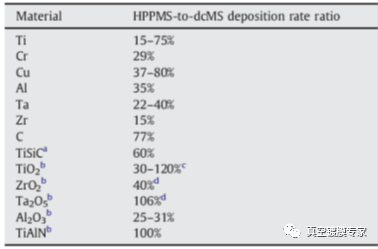Sputtering rate of HiPIMS target
The introduction
Due to the high peak current and high ionization rate of HiPIMS, the dense film layer with excellent performance can be obtained, and the sputtering rate of HiPIMS is also relatively lower. This paper will analyze the reasons for the low sputtering rate of HiPIMS and possible improvement methods.
Dot eyeball
1) Compared with DCMS sputtering rate, the sputtering rate of HiPIMS decreases faster for the target with higher ionization rate
2) For HiPIMS sputtering carbon targets, due to the low ionization rate, the sputtering rate does not decrease much. For metal targets like Cu and Cr, the higher the ionization rate under HiPIMS, the higher the self-supported sputtering rate and the lower the sputtering rate are.
content

The sputtering rate of HIPIMS is determined by sputtering target, pulse structure, reactive sputtering mode and non-reactive sputtering mode. Under the same average power, the sputtering rate of HIPIMS is 15%-120% of that of DCMS, as shown in Table 1. According to Table 1, the sputtering rate of HiPIMS is generally slower than that of DC sputtering.
Table 1 Deposition rate ratio of HiPIMS and DCMS during sputtering of different Materials [1]
Sputtering rate of HiPIMS target
In order to understand the slowing down of HiPIMS sputtering rate, it is necessary to pay attention to two stages in the sputtering process: A, the interaction between plasma and target, that is, the effect on the etching speed of target; B, the transport process of sputtering dissociates from the target surface to the substrate surface. Interaction between plasma and target: Since the voltage range of HiPIMS cathode is 400-2000V, while that of DCMS is 300-400V, it means that under the same power, the average current of HPPMS will be smaller, which will lead to the reduction of ion current of sputtering target, thus reducing the etching rate of target. In the ion transport stage: the high ionization rate obtained by HiPIMS will increase the transport of the ionized metal ions towards the target instead of the substrate, that is, a part of the ions will self-discharge in the self-sputter, in the plasma region.
In order to understand self-sputter, the components of the target ions bombarded by HiPIMS on different targets were tested, which were partly from argon ions and partly from target ions, as shown in Table 2 below. It can be seen that, taking C target as an example, Ar+ is dominant in sputtering, and C+ cannot exist in ion current mainly because the sputtering yield of C is too low and the ionization potential energy of C is relatively high. The same low sputtering yield leads to low sputtering particle flow, resulting in reduced gas dilution. However, due to the high sputtering yield and high ionization rate of Cr and Cu targets, nearly half of the target materials are bombarded with metal ions except Ar+.

Due to the different ionization rates of different materials, the sputtering rate of C in HiPIMS sputtering would not deviate, while the presence of self-sputtering by self-sputter led to the low sputtering rate of Cr and Cu in HiPIMS.
Table 2. Ratio of argon ions and self-sputtering metal ions on target surface bombarded with 500ev incident particles [2-3]
Sputtering rate of HiPIMS target
conclusion
1) Compared with the sputtering rate of DCMS and HiPIMS, the sputtering rate of the target with higher ionization rate decreases faster.
2) Under long pulse width, metal discharge will enter self-sustaining discharge mode, which can increase the type and quantity of ions; High ionization energy materials such as carbon do not increase ionization even at long pulse width, and the sputtering rate does not decrease significantly.
 0769-81001639
0769-81001639
